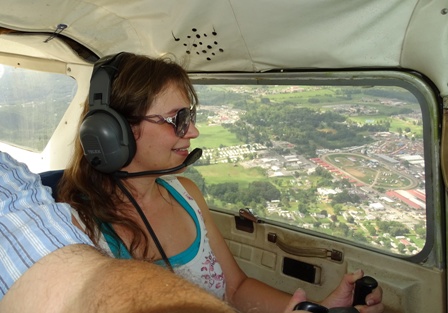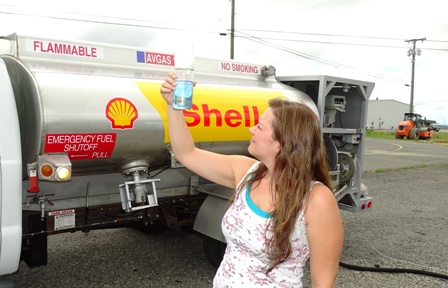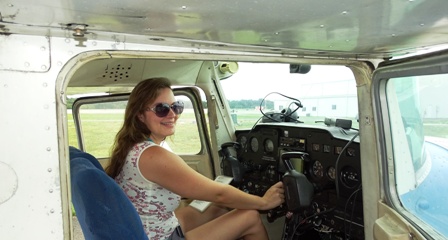
Getting Started on Your Flight Training
Updated May 13, 2023
You don't really need a lot of time, money, reading materials, or complications to Get Started, although it does take some reasonable commitment, and priority, of your time and other resourses, to achieve any goal. This is a breakdown of what to expect right at the beginning, and up through your first solo. You're on the right track already, reading through this website. Your next step is probably just to set up an appointment for your FIRST LESSON. David@EaglesWings.net or text me at 304-445-6046.
Some time ago, one of my relatively new trainees, Amanda Baker, helped me with the pictures for this particular page. You'll see Amanda demonstrating several aspects of preflight inspection, preparation, and flying.
You may take an "Introductory Flight" without proof of citizenship, but the Transportation Security Aministration (TSA) requires your instructor to verify your United States citizenship before you can receive flight training “which can count toward your license.” (How do you do that? Give a guy an introductory lesson, and assure that he doesn't learn anything?) To meet the requirement, we need to retain a copy of your birth certificate, along with your drivers license, (or some other government-issued ID). A copy of your Passport alone can serve as your proof of citizenship. That’s really all you need to start.
Your instructor will probably sell you a log book for about $10, where your official flight time is recorded. Certain elements of flight training and knowledge instruction have to be recorded (logged and signed by your instructor) before you fly solo, others before going on solo cross-country flights, and special review in preparation for your final Practical Test.
Here at Eagels' Wings, a First Lesson usually consists of a flight from Lewisburg to Beckley and return. This flight path crosses the beautiful New River Gorge, and helps you get acquainted with the sensations of flight, the flight controls, instruments, and demonstrates how quickly an airplane can go from one point to another. The lesson usually cost about $200, for 1.4 hours of flight time, a log book, and a $15 insurance surcharge per flight lesson. If the lesson comes out to 1.3 hours, it will be $187.50. See Cost of Flying for more deatils on that subject.
Before You Solo!
As already mentioned, you MUST have a Student Pilot's License, and a Third Class Medical Certificate BEFORE YOU SOLO, PLUS....
You must have logged flight instruction given by an instructor certified for the type of license you are seeking, Sport Pilot, Private Pilot, etc. This instruction and learning must include competency and skill in specific elements of flight.
You are required to take a LOCALLY ADMINISTERED KNOWLEDGE TEST pertaining to the operation and performance of the airplane you are using, as well as the Airport environment in which you are flying. Certain aeronautical and emergency information is included in this exam.
When actually flying solo, but must have with you, your Student Pilot Certificate, your log book with solo endorsements, your Medical Certificate (as required), and Photo ID (usually your drivers license.)
IACRA - Sounds Scary! But it's Not.
You MUST go online to the FAA's IACRA (Integrated Airman Certification and Rating Application) web site, and register as an IACRA user. You will receive an FTN number, and you will set up a user name and password. Next, you submit a STUDENT PILOT APPLICATION. A list of your flight time is not required to obtain a Student Pilot Certificate. Your instructor (or other Certifying Officer) will go online and verify your citizenship and English proficiency. Then you electronically sign the application. Finally, your instructor also signs it. You should receive a temporary Student Pilot Certificate by email in about a week, and your plastic “STUDENT PILOT CERTIFICATE” within a few weeks.
For most aircraft (except Light Sport Aircraft and gliders), YOU MUST have a THIRD CLASS MEDICAL CERTIFICATE BEFORE you solo. This is obtained from certain doctors called Aviation Medical Examiners (AME). A list of those nearest to your area may be found on the Internet. If you have already had a Third Class Medical certificate, which has not been expired too long, you might be eligible for BasicMed certification from your local doctor.
Optional "Renters Insurance"
Many flight training facilities require their trainees, and other renters, to acquire their own "renters insurance" to cover their own liability in the event of an accident. With Eagles' Wings, this is optional. We now have insurance that should cover you. It cost us over $3700 per year, for this insurance to cover student pilots receiving instrucction, flying solo, or licensed pilots renting the airplane. That is the reason for the $15 "insurance surcharge" per lesson, or rental. After the first three lessons, my students each contribute $400 per year toward the cost of our insurance. This is one of the ways we can keep an airplane available for training at a relatively low price.
Still, many aviation "experts" highly recommend renters insurance. Such insurance covers YOUR liability in any aircraft you are legally flying. It is not specific to one certain airplane. You will need personal liability insurance and “HULL COVERAGE” for at least the value of the airplanes you are renting. Renters insurance DOES NOT cover you in an airplane you own. Such insurance probably cost about $350 per year.
After you solo:
After a few local solo flights under your instructor's supervision, you will be flying much more of the time without your instructor. This gives your the opportunity to build your skill, confidence, and knowledge of your home area. When appropriate, you will still be flying with your instructor to master more advanced techniques, precision, and preparation for Cross-Country flights.
Get plenty of solo time and use it for meaningful practice. That will reduce the amount of Dual Instruction you need, saving you money, in meeting the standards for a Pilot’s License.
HAPPY FLYING!
Pictured at left is Amanda Baker formerly of Hinton, West Virginia, during one of her early flying lessons. She is flying over the West Virginia State Fair at Lewisburg. Amanda served our country with many years of military service. I have asked her to help me with this presentation by demonstrating several aspects of preflight preparation. Thanks Amanda. Happy Flying!
Contact Us
David H. Hersman, CFI
Eagles' Wings Flight Training
1458 Henson Road
Clintonville, West Virginia 24931-7158
Cell phone/ text: 304-445-6046
Email: david@eagleswings.net

Thorough Preflight Inspection
Here Amanda is taking fuels samples at four different places in the aircraft's fuel system. Some airplanes have more places to check. We have to be sure we have plenty of fuel, and that it is the right fuel, and perfectly "good fuel." She is checking for the color of the fuel (light blue), any water, or other contamination, and even the right smell.
Always Be Sure!
A thorough preflight insection includes the free movement of all the moveable control surfaces, as well as your fuel, oil, tires, brakes, engine area for anything cracked, bent, broken, burnt, loose, or leaking. Here Amanda is checking the security of the flaps. She will proceed around the airplane inspecting things in a "logical orderly sequence."

Use the Checklist!
After her thorough preflight inspection and servicing, Amanda is using the "Starting Engine Checklist." Certain engine controls, electrical equipment, lights, and radio equipment have to be set right before you start. It is always imperative to know who or what might be nearby before you start the engine and propeller. Safety First!

The Joy of Flying!
Diligent preflight planning, preparation, and servicing helps assure a safe, serene, and successful flight. Almost nothing compares to the ultimate freedom of flying. Three thousand years ago the Psalmist wrote, "Oh that I had wings like a dove, for then I would fly away and be at rest" (Psalm 55:6).